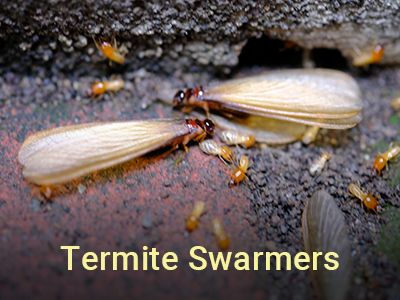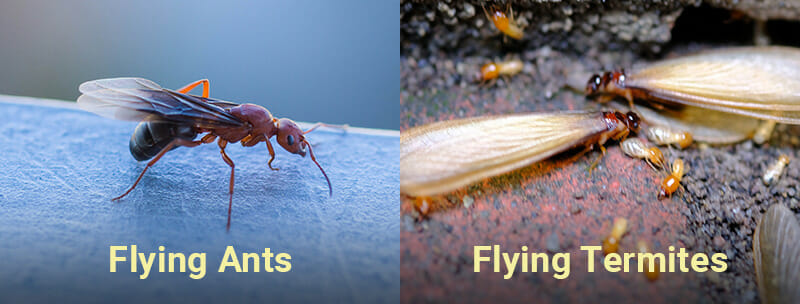Flying ants and termite swarmers are frequently mistaken for one another. And if you’re a homeowner, spotting a cloud of flying insects is usually an unwelcome sight – especially if you suspect they might be flying termites. Flying ants and termites do have some key differences to note, and our experts break them down below.
Can Termites Fly?
To start, we have to address the frequently asked question: can termites fly? Yes! Certain types of termites do fly, and spotting flying termites may be a sign that an infestation is beginning. When the weather warms up, termite colonies often begin to release reproductive winged termite swarmers, also known as alates, whose main purpose is to fly away, mate, and find a place to start a new colony. This typically occurs during termite swarming season, beginning in early spring as the weather warms up. At the same time, winged ants often leave their nests for the same purpose. Unfortunately, it can be hard to determine which flying insect is which. Making this distinction can be a big deal, as termites eat the cellulose found in wood and can cause major damage to nearby wooden structures if they are allowed to start new colonies.

Behavior of Termites vs. Ants
It’s important to try to quickly identify the pest you’re dealing with, regardless of if it’s termites or ants, so a pest management company can put together a treatment plan. Termites and ants behave very differently, and their behaviors can sometimes clue you in if you’re facing a termite or ant infestation.
Termites Eat Cellulose and Cause Damage
Termites eat cellulose found in wood and can cause significant damage to your home. In the event of a termite infestation, they will typically gravitate toward areas with plenty of wood. Termites can’t actually survive without extremely specific moisture levels, so they build mud tubes to provide shelter. Termites will chew wooden structures, including property foundations which can lead to structural damage.
Carpenter Ants May Destroy Wood, but Not Because They’re Hungry
Most ants have multiple food sources, and carpenter ants are no exception. Carpenter ants don’t eat wood, but they will chew it up and spit it out, leaving damage in their wake. Carpenter ants will bore holes and build tunnels in search of food as opposed to the mud tubes termites craft.
Termites and Ants Both have Flying Varieties
During swarming season, termites send their swarmers in an attempt to start new colonies. In a similar manner, several varieties of ants will send out their swarmers, too. While the behavior of both specimens may be similar, you may observe some core physical differences.
Physical Differences Between Flying Ants and Flying Termites
Chances are, if you see a cloud of flying termites or flying ants, you won’t be able to tell the difference between the two. Both termite and ant colonies will release their winged reproductive swarmers (also called alates) about mid-morning on the warm day that follows a rainy day in the spring or summer. Since termite swarmers are poor fliers, they can only tolerate a light breeze. If the wind picks up, they will cease swarming and try again later that day or on another day. Also, termites have trouble controlling moisture loss from their bodies, so a calm day with high humidity is ideal for a successful swarm.
Even though an ant swarm and flying termite swarm will look similar, the key to identification lies in closely examining a sole ant or termite. If you view a termite swarmer and an ant swarmer side by side, you would be able to identify which is which based on a few factors:
- Wings: Termites have four wings of almost equal length that have many barely visible, pale veins. Ants also have four wings, but their hind wings are much shorter and smaller than those of termites, and their wings have only a few veins that are dark in color. Furthermore, termite wings easily break off as they prepare to mate, and they will often leave their discarded wings in piles as they begin building a new colony. In contrast, ants keep their wings until they’ve mated and begun establishing a company, and once they become queen ants, their wings come off.
- Body: The termite has a uniform body shape with a wide, straight waist behind the spot on their exoskeletons where their wings are attached. In contrast, ants have constricted or pinched waists at the spot where their wings are attached.
- Antennae/feelers on the head: The antennae of termites resemble a series of round beads. In contrast, ants have straight antennae that are “elbowed”—the first segment is about as long as the rest of the segments combined and the rest of the segments are all small.

What to Do If You Spot Flying Ants or Flying Termites
If you step outside and see a fuzzy cloud of buzzing insects, you may feel uneasy — and that unease isn’t entirely unwarranted, especially if it turns out you’re looking at a termite swarm. Termite infestations often begin as a result of swarming termites building new colonies in wooden structures, and if you don’t act promptly, your home could be invaded. Flying ants can cause similar problems with swarming, building new nests, and looking for food on your property, but they won’t damage the structural integrity of your home like termites will. If you find swarming insects on your property, contact a pest professional immediately and determine if you’re at risk for a termite infestation.
A pest control company can conduct a thorough termite inspection to determine 1) whether you’re dealing with termites at all and 2) the best treatment plan to eradicate an active infestation. At Dodson Pest Control, we take a holistic approach to all our treatments. One home may call for a termite baiting system, while another may benefit from a liquid insecticide like Termidor. Before you’re facing severe structural damage, give us a call — we can perform a free inspection and advise you on next steps.
Schedule a
Free Inspection

